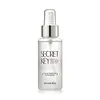What's inside
What's inside
 Key Ingredients
Key Ingredients

 Benefits
Benefits

 Concerns
Concerns

No concerns
 Ingredients Side-by-side
Ingredients Side-by-side

Water
Skin ConditioningDipropylene Glycol
HumectantGlycerin
HumectantGlycereth-26
Humectant1,2-Hexanediol
Skin ConditioningDipentaerythrityl Hexa C5-9 Acid Esters
Skin ConditioningPanthenol
Skin ConditioningHydroxyethyl Acrylate/Sodium Acryloyldimethyl Taurate Copolymer
Emulsion StabilisingMacadamia Integrifolia Seed Oil
Skin ConditioningCaprylic/Capric Triglyceride
MaskingStyrene/Vp Copolymer
Phytosphingosine
Skin ConditioningCeramide NP
Skin Conditioning2,3-Butanediol
HumectantTocopherol
AntioxidantCeramide Ns
Skin ConditioningCeramide As
Skin ConditioningCeramide AP
Skin ConditioningCholesterol
EmollientCeramide EOP
Skin ConditioningPhytosteryl/Octyldodecyl Lauroyl Glutamate
Skin ConditioningAllantoin
Skin ConditioningAcrylates/C10-30 Alkyl Acrylate Crosspolymer
Emulsion StabilisingHydrogenated Lecithin
EmulsifyingSodium Hyaluronate
HumectantSorbitan Isostearate
EmulsifyingHeptasodium Hexacarboxymethyl Dipeptide-12
Skin ConditioningSorbic Acid
PreservativeGlyceryl Stearate
EmollientTromethamine
BufferingPhenyl Trimethicone
Skin ConditioningEthylhexylglycerin
Skin ConditioningDisodium EDTA
Water, Dipropylene Glycol, Glycerin, Glycereth-26, 1,2-Hexanediol, Dipentaerythrityl Hexa C5-9 Acid Esters, Panthenol, Hydroxyethyl Acrylate/Sodium Acryloyldimethyl Taurate Copolymer, Macadamia Integrifolia Seed Oil, Caprylic/Capric Triglyceride, Styrene/Vp Copolymer, Phytosphingosine, Ceramide NP, 2,3-Butanediol, Tocopherol, Ceramide Ns, Ceramide As, Ceramide AP, Cholesterol, Ceramide EOP, Phytosteryl/Octyldodecyl Lauroyl Glutamate, Allantoin, Acrylates/C10-30 Alkyl Acrylate Crosspolymer, Hydrogenated Lecithin, Sodium Hyaluronate, Sorbitan Isostearate, Heptasodium Hexacarboxymethyl Dipeptide-12, Sorbic Acid, Glyceryl Stearate, Tromethamine, Phenyl Trimethicone, Ethylhexylglycerin, Disodium EDTA
Water
Skin ConditioningButylene Glycol
HumectantGlycerin
HumectantAlcohol Denat.
AntimicrobialGalactomyces Ferment Filtrate
HumectantCeramide NP
Skin ConditioningAloe Barbadensis Leaf Extract
EmollientChamomilla Recutita Extract
Skin ConditioningCentella Asiatica Extract
CleansingCamellia Sinensis Leaf Extract
AntimicrobialHamamelis Virginiana Extract
AntiseborrhoeicOryza Sativa Bran Extract
Skin ConditioningPortulaca Oleracea Extract
Skin ConditioningPanax Ginseng Root Extract
EmollientAcanthopanax Senticosus Root Extract
Skin ConditioningOligopeptide-1
Skin ConditioningSodium Hyaluronate
HumectantOctyldodecanol
EmollientHydrogenated Lecithin
EmulsifyingBoswellia Serrata Resin Extract
SmoothingPEG-60 Hydrogenated Castor Oil
EmulsifyingCaprylhydroxamic Acid
Caprylyl Glycol
Emollient1,2-Hexanediol
Skin ConditioningDisodium EDTA
Parfum
MaskingWater, Butylene Glycol, Glycerin, Alcohol Denat., Galactomyces Ferment Filtrate, Ceramide NP, Aloe Barbadensis Leaf Extract, Chamomilla Recutita Extract, Centella Asiatica Extract, Camellia Sinensis Leaf Extract, Hamamelis Virginiana Extract, Oryza Sativa Bran Extract, Portulaca Oleracea Extract, Panax Ginseng Root Extract, Acanthopanax Senticosus Root Extract, Oligopeptide-1, Sodium Hyaluronate, Octyldodecanol, Hydrogenated Lecithin, Boswellia Serrata Resin Extract, PEG-60 Hydrogenated Castor Oil, Caprylhydroxamic Acid, Caprylyl Glycol, 1,2-Hexanediol, Disodium EDTA, Parfum
 Reviews
Reviews

Ingredients Explained
These ingredients are found in both products.
Ingredients higher up in an ingredient list are typically present in a larger amount.
1,2-Hexanediol is a synthetic liquid and another multi-functional powerhouse.
It is a:
- Humectant, drawing moisture into the skin
- Emollient, helping to soften skin
- Solvent, dispersing and stabilizing formulas
- Preservative booster, enhancing the antimicrobial activity of other preservatives
Ceramide NP is a type of ceramide and formally known as ceramide 3.
Ceramides are intercellular lipids naturally found in our skin that bonds dead skin cells together to create a barrier. They are known for their ability to hold water and thus are a great ingredient for dry skin.
Ceramides are an important building block for our skin barrier. A stronger barrier helps the skin look more firm and hydrated. By bolstering the skin ceramides act as a barrier against irritating ingredients. This can help with inflammation as well.
If you would like to eat ceramides, sweet potatoes contain a small amount.
Read more about other common types of ceramides here:
Ceramide AP
Ceramide EOP
Disodium EDTA plays a role in making products more stable by aiding other preservatives.
It is a chelating agent, meaning it neutralizes metal ions that may be found in a product.
Disodium EDTA is a salt of edetic acid and is found to be safe in cosmetic ingredients.
Learn more about Disodium EDTAGlycerin is already naturally found in your skin. It helps moisturize and protect your skin.
A study from 2016 found glycerin to be more effective as a humectant than AHAs and hyaluronic acid.
As a humectant, it helps the skin stay hydrated by pulling moisture to your skin. The low molecular weight of glycerin allows it to pull moisture into the deeper layers of your skin.
Hydrated skin improves your skin barrier; Your skin barrier helps protect against irritants and bacteria.
Glycerin has also been found to have antimicrobial and antiviral properties. Due to these properties, glycerin is often used in wound and burn treatments.
In cosmetics, glycerin is usually derived from plants such as soybean or palm. However, it can also be sourced from animals, such as tallow or animal fat.
This ingredient is organic, colorless, odorless, and non-toxic.
Glycerin is the name for this ingredient in American English. British English uses Glycerol/Glycerine.
Learn more about GlycerinHydrogenated Lecithin is created from the hydrogenation of lecithin (a group of phospholipids). Hydrogenation is a chemical reaction between hydrogen and another element.
This ingredient is an emollient and emulsifier. As an emollient, it helps soften skin by trapping moisture within. As an emulsifier, it prevents oil and water ingredients from separating.
Sodium Hyaluronate is hyaluronic acid's salt form. It is commonly derived from the sodium salt of hyaluronic acid.
Like hyaluronic acid, it is great at holding water and acts as a humectant. This makes it a great skin hydrating ingredient.
Sodium Hyaluronate is naturally occurring in our bodies and is mostly found in eye fluid and joints.
These are some other common types of Hyaluronic Acid:
Learn more about Sodium HyaluronateWater. It's the most common cosmetic ingredient of all. You'll usually see it at the top of ingredient lists, meaning that it makes up the largest part of the product.
So why is it so popular? Water most often acts as a solvent - this means that it helps dissolve other ingredients into the formulation.
You'll also recognize water as that liquid we all need to stay alive. If you see this, drink a glass of water. Stay hydrated!
Learn more about Water